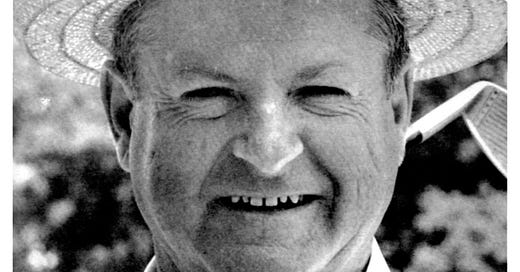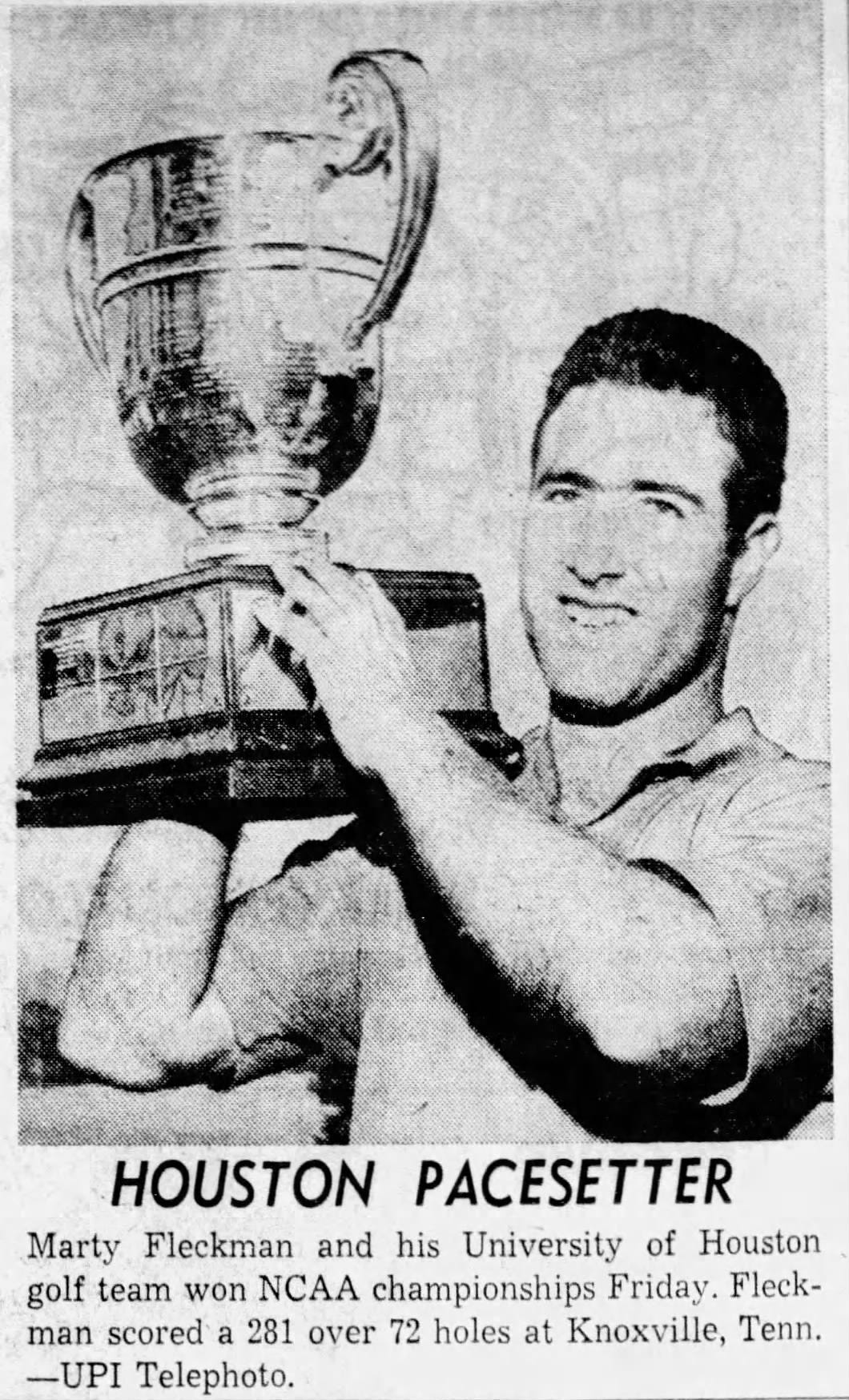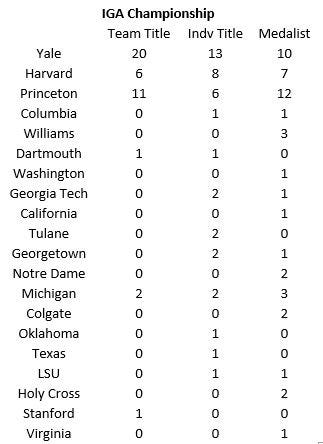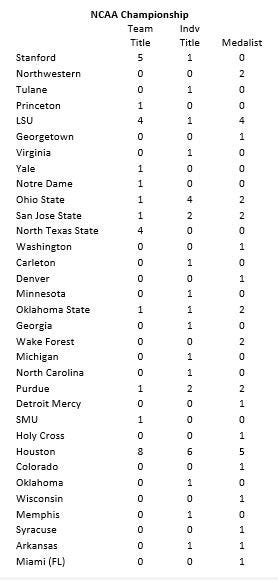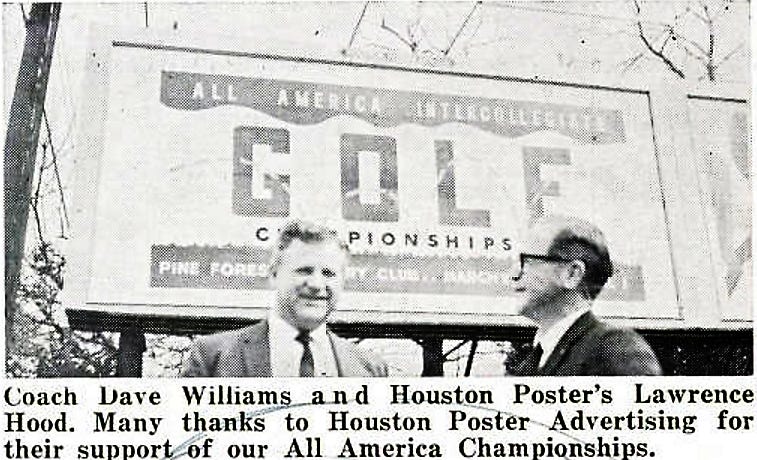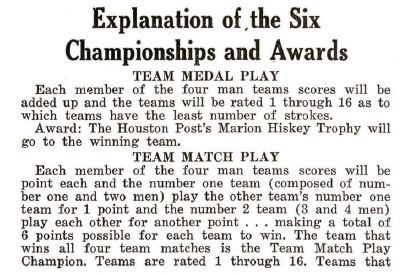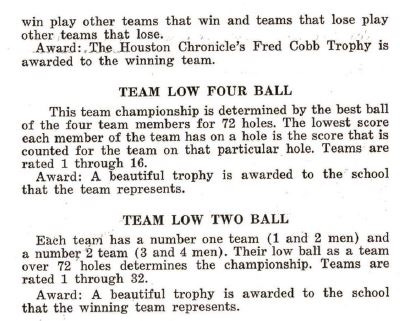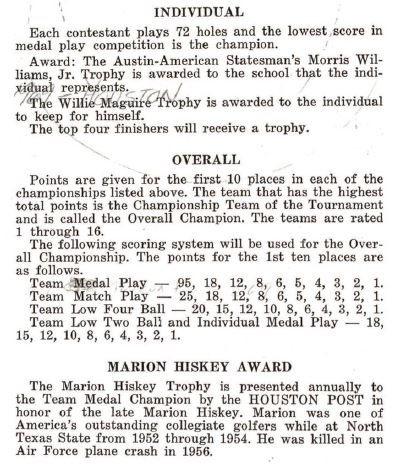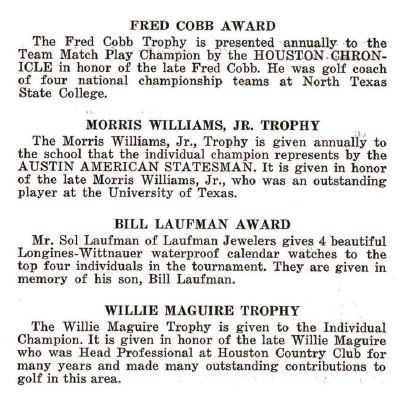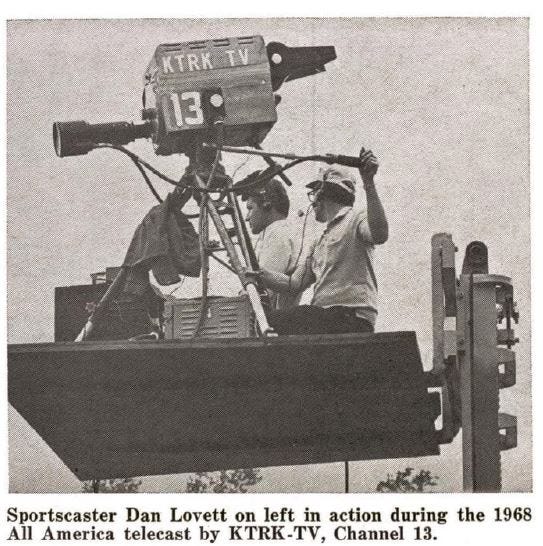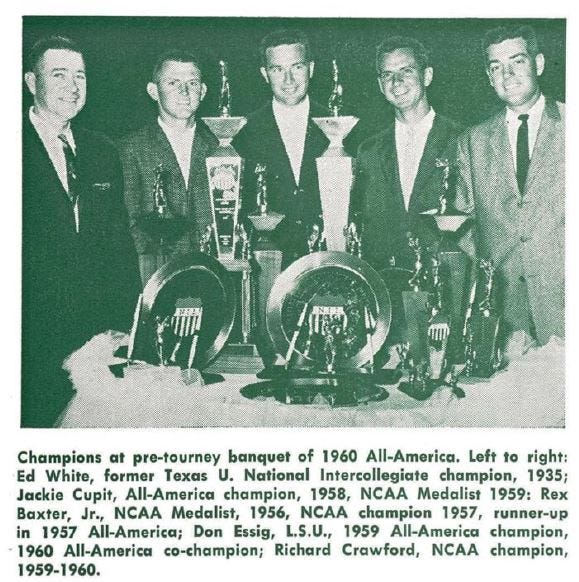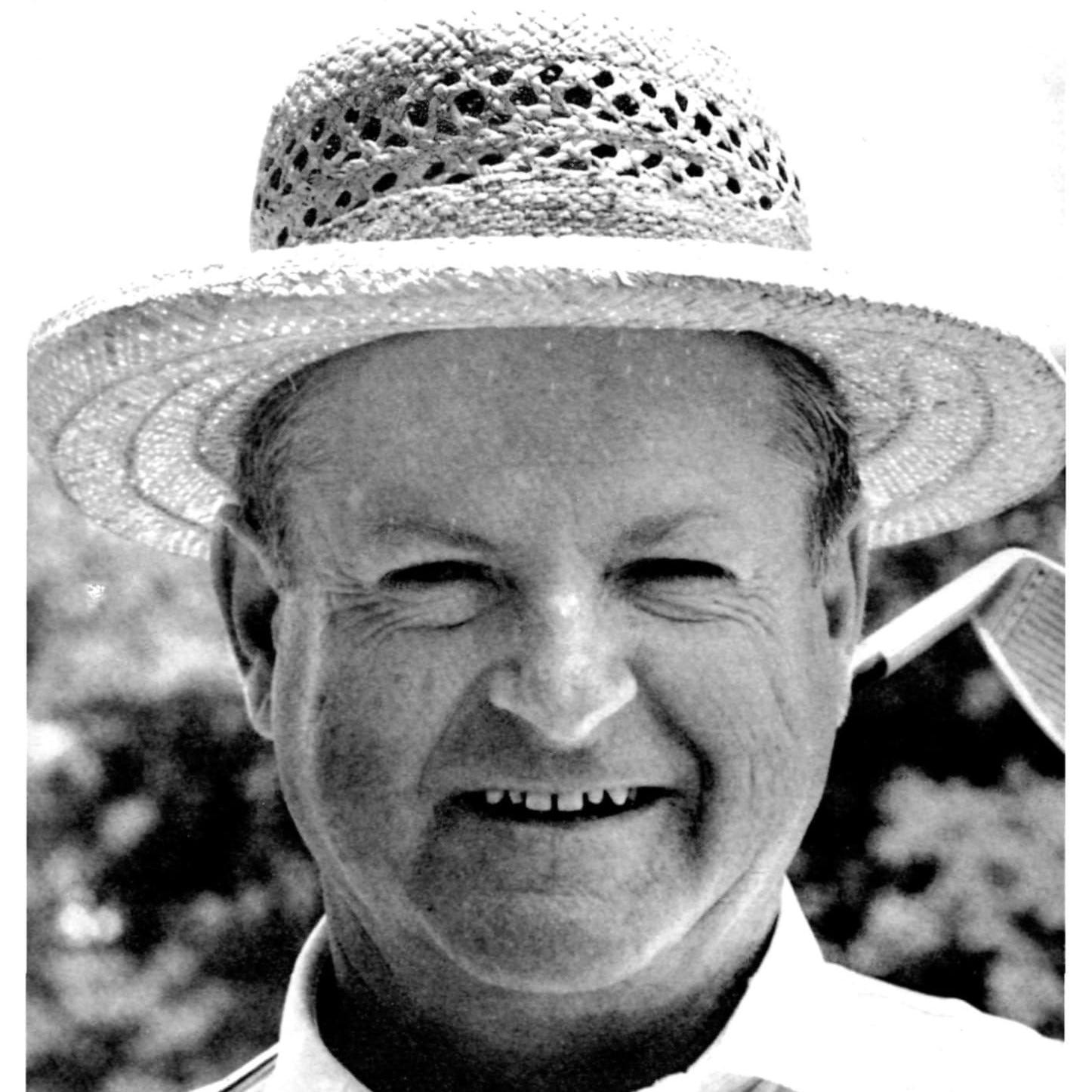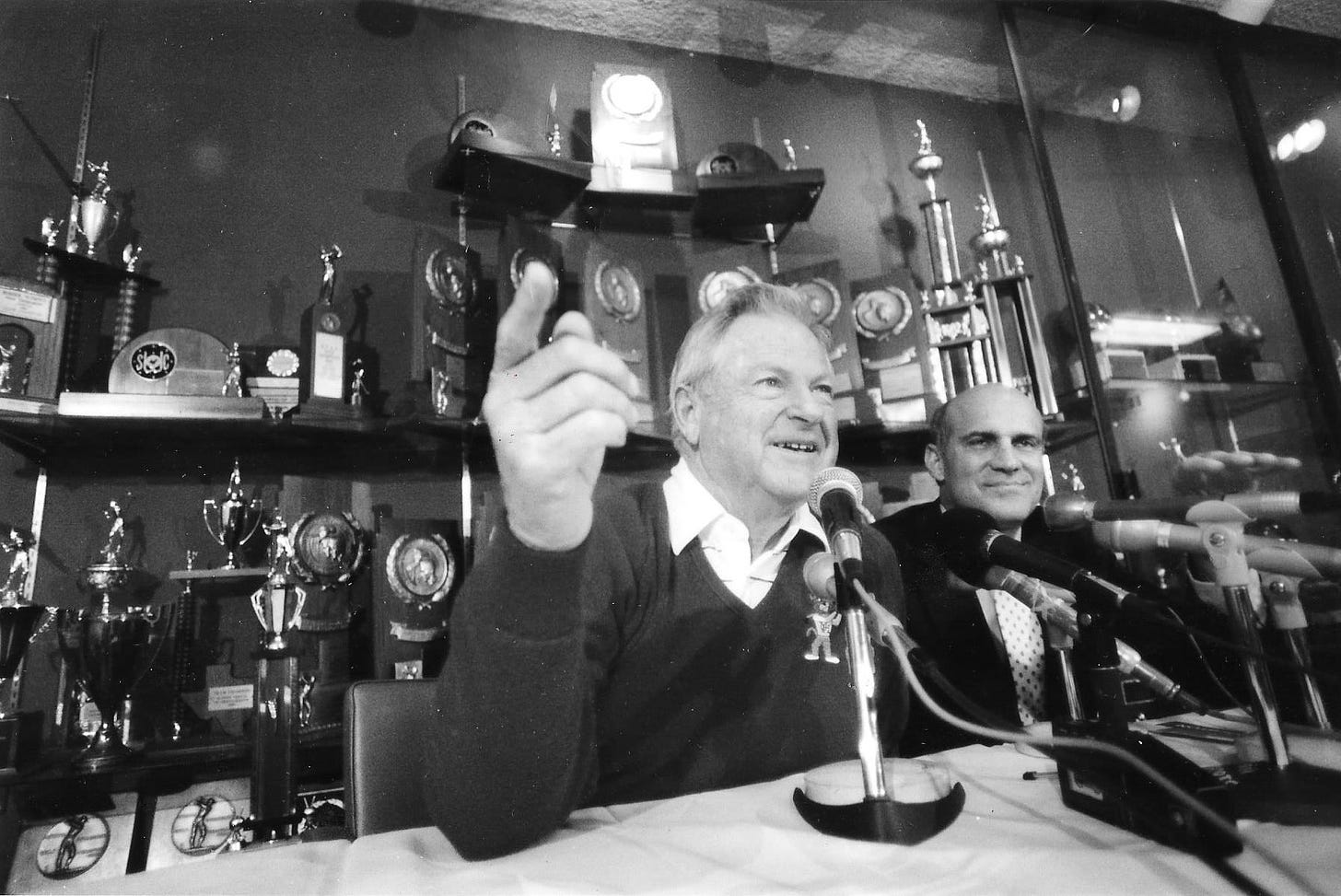This is part of a series on the Men’s Collegiate Championships
NCAA Championship Era: 1939-NOW
Intercollegiate Championship #68: June 23-26, 1965
Host: Holston Hills CC (University of Tennessee)
The NCAA championship returns to the site of the 1955 tournament where LSU captured its 4th team title over runner-up North Texas (State) - thanks in large part to the record-tying low medalist score (136 for 36 holes) - and Purdue’s Joe Campbell earned the university its second individual title (Fred Wampler, 1950). Today, the private Donald Ross designed course located outside Knoxville annually hosts the Visit Knoxville Open Korn Ferry Tour event.
Format
In the last two decades since the end of WWII, the number of colleges across the country who not only fielded a team but were also willing to send them (or an individual representative) to the national championship became practically unmanageable. After a successful but bogged down championship at Eugene CC in 1959, Coach Dave Williams [Houston] - elected President of the Golf Coaches Association for the upcoming season - pushed for a limit on the number of players a team could bring, changing the traditional 6-count-4 scoring to 5-count-4, believing the extra player was unnecessary.
Before the start of the 1965 tournament, Robert Kepler - legendary Ohio State coach serving in his second term as NCAA Golf Chairman (1959, 1963-65) - announced some radical changes which put the NCAA Committee in charge of limiting the field in a way not seen since the IGA era.
Team and Individual stroke play
Day 1 = 18 holes
Day 2 = 18 holes
**36 holes determines Team championship
**Cut to top 60 individuals (and ties)
Day 3 = 36 holes
**72 holes determines Individual championship
New Format details
5-count-4 starting with the 1960 championship
Teams were selected by the NCAA Committee to compete for the national championship, effectively making the championship an “invitational”
Was done based on the suggestion by the Golf Coaches Association
A screening committee was instituted for each NCAA district (around 8) to pick the top teams and individuals from their area to send to the championship
Limited the field to around 225 total players, “far under the usual starting brigade”
All Stroke Play with Individual cuts
This had only been done once before in a one-off special occasion for the war-affected 1946 championship
NOTE: in 1968 the Team championship was expanded out to the full 72 holes which later necessitated a team cut after 36/54 holes
**The NCAA was already making decisions with TV broadcast in mind
NOTE: this may also be thanks in part to Dave Williams based on his successfully getting tv coverage of the AAII in 1965 (see below)
Results
Team Champ: Houston (8 NCAA, 8 overall)
Houston was already in the middle of an absolutely historic run which netted 7 championships in the previous 9 tournaments, so they were easily the favorites coming into the 1965 tournament. They did not disappoint. Led by Marty Fleckman who backed up his first round five-under-par 67 with a 68 to set a new 36 hole record (135), Houston (577) outpaced second place Cal State LA by 10 strokes to win its 8th national championship. A minor controversy cropped up during the second day when a rainstorm delayed the second round. Some players and coaches were apparently unhappy with the course conditions before play was halted, but tournament officials were apparently satisfied that the course had dried out enough to finish play after about a 45 minute delay. Since some players hadn’t started their round at the time of the delay, completely halting play for the day would have wiped out the scores for those players already on the course (or finished) and the second round would have been played over again fresh the next day.
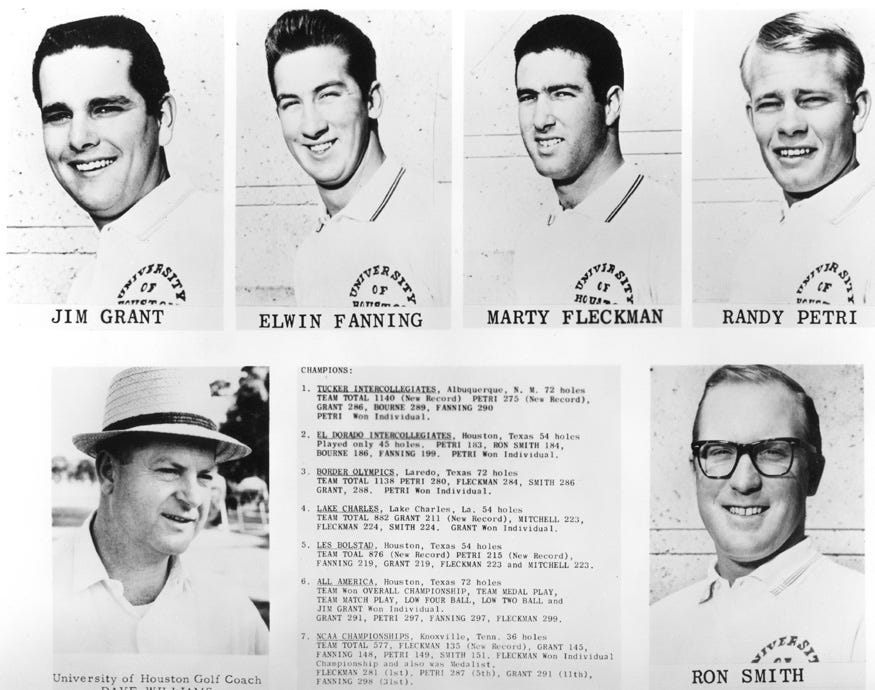
Individual Medalist/Champ: Marty Fleckman [Houston]
Although players were used to advancing into the individual tournament after team play, now their scores from the team competition would carry over into the individual portion to determine the individual champion. Houston’s Marty Fleckman had built up a decent four-stroke lead with his historically low 135 for the first 36 holes, but stumbled a bit on the last day, posting a morning 72 and afternoon 74. His 281 (-7) total was just good enough to outlast a charging Jim Wiechers [Santa Clara] who had birdied the final two holes to post a 282. Knowing what was on the line, Fleckman came into the 18th (72nd) hole needing a par to tie or a birdie to win. Regarding the 12-foot birdie putt he sank for the title, Fleckman told reporters “I wanted to go for it. . . I didn’t want to be short.” In the same 10 year span that had netting Houston 8 team titles, Fleckman earned their SIXTH individual title!
Fleckman would go on to be inducted into multiple halls of fame and made a splash early on the pro tour.
Championship Award Count
*Note: these lists are not alphabetical or numerically-ordered, but rather time-based such that a team is added to the list when they earned their first award
EXTRA HOLES: All-American Intercollegiate Invitational (AAII, commonly pronounced “Double-A, Double-I” or just “The All-American”)
When your golf tournament has its own tagline, you known you have something special. Dave Williams knew he would have something special when he pushed for the creation of the AAII in 1955, and thanks to his many innovative ideas and tireless passion it more than lived up to the billing as “America’s Most Exciting Golf Championships.” Why the plural “championships”? Because this tournament was practically six run simultaneously. In his book How to Coach and Play Championship Golf, Coach Williams details the format for the “ideal” tournament which features a number of different ways to keep teams and players engaged over the course of 36-72 holes. Although we would highly recommend reading his book to get the full effect (and because its a great read), it ultimately boils down to this: medal match. Using the typical 18 hole score each player posted, the AAII tournament officials would use that score to:
Determine the “traditional” 4-count-4 team medal/stroke play score champion as well as the (again traditional) individual medalist
Determine the team match play score against their designated opponent, with winning teams playing their “matches” against other winning teams in a bracket as the tournament progressed
Determine the two-ball (use the best score from each hole) team score, which is designated at the start of the tournament where a coach will select player 1 and 2 from their team at large to be School Team A two-ball team and players 3 and 4 to be School Team B. These two-ball teams would compete in both medal/stroke play competitions and match play brackets
Determine the overall team four-ball score, which can also be competed in both medal play and match play brackets
While all of this seems like a lot to take in, it was all up to the tournament officials to keep track and appears to have been incredibly exciting for both the players and spectators who were kept engaged throughout the tournament. It helped that each of these categories, as well as things like daily low scores, came with their own prizes - usually incredibly nice trophies or plaques. Here is a breakdown of the prizes awarded during the 1969 AAII, as explained in the program:
Other innovations from the AAII include: Coach’s preferred 4-count-4 format, advertising for the event including a huge array of extra-curricular activities, exciting play-by-play coverage for radio, first tv coverage (in 1965!), recorded 16-minute tape for sale (at least in 1969) boasted “color and sound featuring the exciting moments of the previous All America tournaments” and narrated by a young Harry Kalas (then part of the Astro Radio Network), charging admission after finding out it actually encouraged more people to come, making enough money to actually turn a profit to go towards the athletic department and other sports, and even team jerseys which had the team name on the back (a look you still sometimes see today) and was proudly worn by those teams during other tournaments.
Overall, in its heyday, the AAII was not a mere golf tournament, it was an event. Prior to the start there was usually a heavily-attended banquet with as many as 500 people in attendance, a parade, a beauty pageant (thankfully not the golfers), and as many other spectacles that Coach Williams could put together, up to and including cheerleaders on the golf course. In a 1969 Sports Illustrated article on the event, Coach Williams was quoted as saying, “The NCAA tournament is the U.S. Open of college golf and we are the Masters.” Based on the inclusion of extra-curriculars that we’re confident you will never see at Augusta, the article dubbed it the Ben-Hur Open instead. We’re not sure exactly when the extra stuff was cut out - likely before Coach Williams’s retirement - but we certainly would love to see an event with this much life and character back in college golf, even as unlikely as that will ever be.
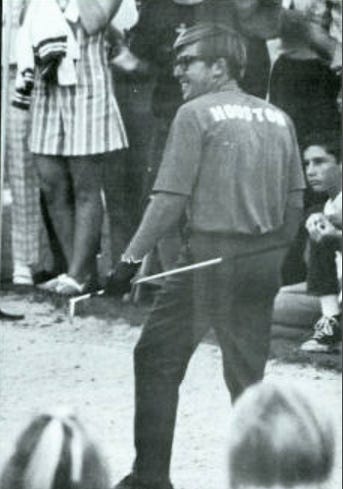
The AAII was run annually from 1955 to 1990. After a brief pause, it resumed in 1992 and ran until 1997. The schedule was sporadic for a while, with Houston hosting from 2006 to 2009, 2012, and and finally becoming an annual event again in 2016 until the present (with one weather cancellation in 2021). Houston and Oklahoma State have taken home the majority of the traditional team stroke play titles in the tournament’s history, and the impressive list of individual winners includes: Jacky Cupit, Homero Blancas, Kermit Zerley, Hal Underwood, Bob Clark, Andy North, Tom Kite, Andy Bean, Willie Wood, Steve Elkington, and Gary Woodland.
One last note that will tie into the Dave Williams section is a comment on the name: The All-American. At the time of the tournament’s creation, golf did not select All-Americans the way other sports like football and basketball had been doing for years. That changed in 1958 with the first selection of six players each for the 1st, 2nd, and 3rd team (NOTE: 6 players matches the then-current 6-count-4 format), with a Houston player making each team. The reason we bring this up is because it’s yet another thing that has ties to Coach Dave Williams who may or may not have been the instigator.
COACHES CORNER: Dave Williams [Houston]
As one of the most highly decorated coaches in the history of collegiate sports, you might not expect to learn that Dave Williams’s start in coaching - and even in his chosen sport - was practically accidental. He once gave an exceptional interview which can be viewed here where he outlined his introduction to golf when teaching in the University of Houston engineering department after WWII and being talked into coaching the golf team by the athletic director Harry Fouke who was the coach at the time.
Coach Williams didn’t take over a historically good team (or even mediocre team to be honest), but he had a goal to win a national championship which he achieved in only five short years. He set out immediately to learn how to make his team the best, so first he reached out to the best at the time: North Texas (State) Coach Fred Cobb who had just won his third of four straight championships and was at the summit of the college golf mountain. As the story goes, Coach Williams didn’t learn the lesson he thought he would the day his team showed up for the match against North Texas, instead finding that Coach Cobb had forgotten about the match entirely which left the Houston team to play a match against a cobbled together group of UNT students who still managed to “soundly” beat the Houston golf team. Ouch.
According to the biography linked above, this event convinced Coach Williams that team matches - the heretofore “normal” college golf competitions outside of the national championship and select tournaments such as the Border Olympics - were not the best way to play team golf, and that instead actual tournaments using the 5-count-4 method of scoring was superior. Make no mistake, Coach Williams was adamant that golf was a team sport and strove to instill this mantra into all of his players, a sentiment that still applies throughout the sport today.
There’s not nearly enough space to cover even a significant fraction of the details we would like, however what follows is some high points for Coach Williams’s championships and near misses over the course of a truly historic (a word that feels inadequate here) career:
1952: NCAA = 11th
Missouri Valley Conference (MVC) team runner-up
1953: NCAA = 8th
MVC team = 3rd
1954: NCAA = 5th
MVC team runner-up
1955: NCAA = T4
MVC team runner-up
1956: NCAA = CHAMPION
MVC team champions, individual = Rex Baxter
1957: NCAA = CHAMPION, NCAA individual Champ = Rex Baxter
MVC team champions, individual = Rex Baxter
1958: NCAA = CHAMPION, NCAA individual Champ = Phil Rodgers
MVC team champions, individual = Phil Rodgers
1959: NCAA = CHAMPION, NCAA individual Champ = Dick Crawford
MVC team champions, individual = Jacky Cupit
1960: NCAA = CHAMPION, NCAA individual Champ = Dick Crawford
MVC team champions, individual = Jacky Cupit
1961: NCAA = T11
no conference affiliation
1962: NCAA = CHAMPION, NCAA individual Champ = Kermit Zarley
no conference affiliation
1963: NCAA = Runner-Up (Oklahoma State)
no conference affiliation
1964: NCAA = CHAMPION
no conference affiliation
1965: NCAA = CHAMPION, NCAA individual Champ = Marty Fleckman
no conference affiliation
1966: NCAA = CHAMPION
no conference affiliation
1967: NCAA = CHAMPION
no conference affiliation
1968: NCAA = Runner-Up (Florida)
no conference affiliation
1969: NCAA = CHAMPION
no conference affiliation
1970: NCAA = CHAMPION, NCAA individual Champ = John Mahaffey
no conference affiliation
1971: NCAA = Runner-Up (Texas)
no conference affiliation
1972: NCAA = Runner-Up (Texas)
no conference affiliation
1973: NCAA = 6th
Southwest Conference (SWC) team runner-up
1974: NCAA = 3rd
SWC team Co-Champion, individual Champ = Keith Fergus
1975: NCAA = 12th
SWC team Co-Champion
1976: NCAA = 3rd
SWC team Champion, individual Champ = Keith Fergus
1977: NCAA = CHAMPION
SWC team Champion, individual Champ = Ed Fiori
1978: NCAA = 18th
SWC team Champion, individual Champ = Terry Snodgrass
1979: NCAA = T9
SWC team Champion, individual Champ = Fred Couples
1980: NCAA = MC (18th)
SWC team Champion, individual Champ = Ray Barr
1981: NCAA = 3rd
SWC team runner-up, individual Champ = Ray Barr
1982: NCAA = CHAMPION, NCAA individual Champ = Billy Ray Brown
SWC team runner-up
1983: NCAA = 3rd
SWC team runner-up
1984: NCAA = CHAMPION
SWC team Champion, individual Co-Champs = Steve Elkington & John Slaughter
1985: NCAA = CHAMPION
SWC team Champion, individual Champ = Steve Elkington
1986: NCAA = 5th
SWC team runner-up
1987: NCAA = 10th
SWC team runner-up, individual Champ = Tray Tyner
FINAL TOTALS: 37 year career
NCAA Team Championships = 16 (in 37 appearances = 43%)
At least 2 championships every decade from the 1950s to the 1980s
Two different runs of 4+ championships in a row, longest = 5
Peak run from 1956-1972 (17 years)
12 championships and 4 runner-up finishes
Runner-Ups = 4, 3rd place = 5
Finished in top 3 in 24 of 37 appearances = 65%
Finished in top 5 in 27 of 37 appearances = 73%
Finished outside the top 10 only 5 times
NCAA Individual Championships = 8
7 different players
5 match play, 3 stroke play
5 additional medalists during qualifying for match play
Conference Team Championships = 14 (in 25 appearances = 56%)
Never finished worse than 3rd
Runner-up = 10, 3rd place = 1
Conference Individual Championships = 16
10 different players
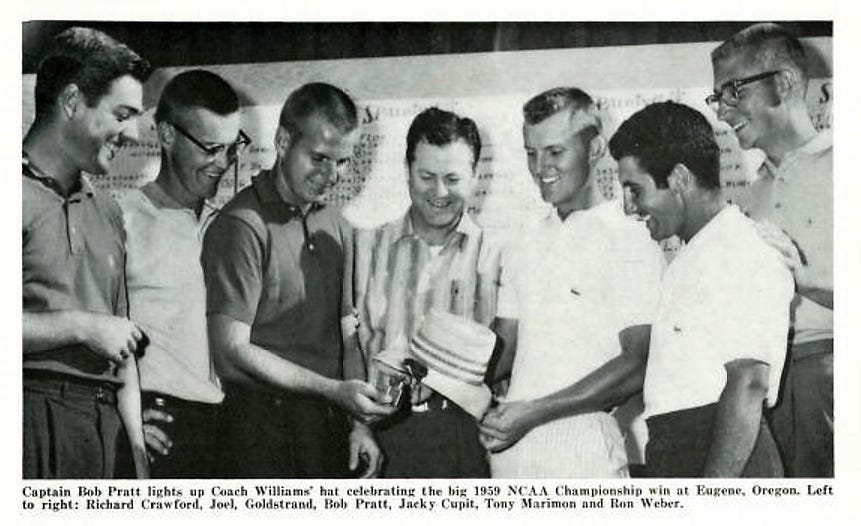
One fun Coach Williams tradition was that every time Houston won an NCAA title the team would burn coach’s iconic hat. As we see, Coach must have happily gone through a lot of hats. Because of both his teams’ success and his incredible impact on the history of college golf, the Golf Coaches Association (GCAA) named their Coach of the Year award after Dave Williams which is awarded to a deserving coach at each of the 6 levels of men’s collegiate golf (DI, DII, DIII, NAIA, NJCAA, and NJCAA DII) beginning in 1988, the year after his retirement. In 2011, Houston broke ground on the Dave Williams Academy, a state-of-the-art teaching facility which continues to further the standard of golf excellence its namesake started nearly three-quarters of a century before. Coach Dave Williams was jokingly called “National Champion Williams” because of his absurd prediction that he would win a national championship in golf when he took over a team in 1952 that had never even competed in the NCAAs, but by his retirement in 1987 he would lovingly be referred to as “Mr. College Golf” for accomplishing more than anyone else in the history of the sport.
If you would like to learn more about the man/myth/legend that is Coach Dave Williams, we’d highly suggest starting with his own book as well as this fascinating Sports Illustrated article from 1967.
Thanks for reading!
Up Next:
In the next post we will cover the Ben Crenshaw / Texas era by highlighting the 1972 championship which was the only time that the individual championship was shared between two players; the fact that they were teammates probably made it just fine with both.

